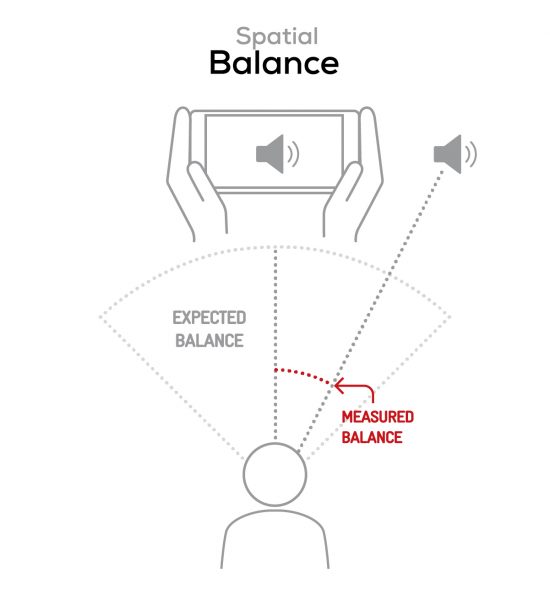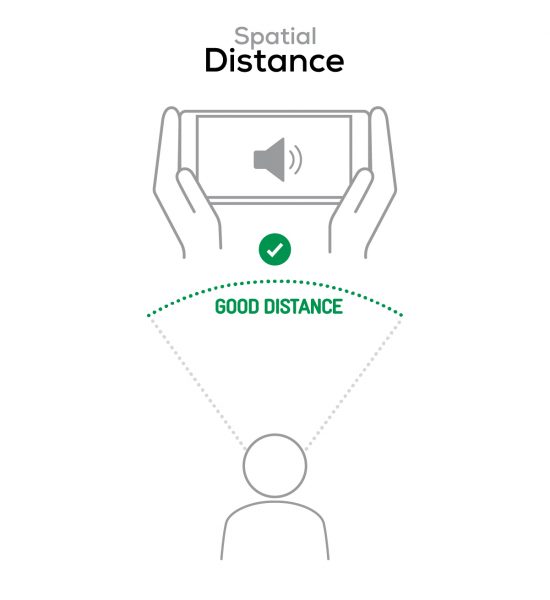The Pixel 6 Pro is Google’s 2021 flagship smartphone, featuring a 6.7-inch LTPO OLED display with 120Hz refresh rate and QHD+ resolution, a triple camera with ultra-wide and tele modules accompanying the primary shooter — a first, in the Pixel family! — and Google’s brand new in-house-developed Tensor chipset.
In terms of audio, the Google Pixel 6 Pro is equipped with two speakers for stereo playback, and three microphones for stereo recording, noise reduction, speech enhancement, and audio zoom. We put Google’s latest top-end phone through our rigorous DXOMARK Audio test suite to measure its performance both at recording sound using its built-in microphones, and at playing audio back through its speakers. In this review, we will break down how it fared in a variety of tests and several common use cases.
Key audio specifications include:
-
Two speakers (one bottom right, side-firing, and one top, front-firing)
- Three microphones
- Audio Zoom
- USB Type-C input for headphones (no 3.5mm jack)
About DXOMARK Audio tests: For scoring and analysis in our smartphone audio reviews, DXOMARK engineers perform a variety of objective tests and undertake more than 20 hours of perceptual evaluation under controlled lab conditions. This article highlights the most important results of our testing. Note that we evaluate both Playback and Recording using only the device’s built-in hardware and default apps.
(For more details about our Playback protocol, click here; for more details about our Recording protocol, click here.)
Test summary
Google Pixel 6 Pro


 27th
27th 13th
13thPlayback
Pros
- Deeper low-end extension and stronger low midrange than Pixel 6, which also helps the sensation of punch
- Tonal Balance remains fairly identical at soft volumes
- Natural position of hands doesn’t block any speaker
Cons
- The center is shifted towards the right when listening to music.
- Dynamics are impaired by heavy compression at maximum volume.
- Stereo doesn’t follow the phone’s rotation when listening to music (only when watching movies).
- Numerous artifacts detected
Recording
Cons
- Limited wideness and poorer localizability in life videos
- Inferior spatial results in selfie videos
With an overall Audio score of 71, the Google Pixel 6 Pro bests its predecessors but remains within the average of all the phones we have tested to date, noticeably behind the 81 achieved by our current ex-aequo top-scorer, the Black Shark 4 Pro, and behind the Apple iPhone 13 Pro’s score of 75.
In playback, the Google Pixel 6 Pro is rather well suited for gaming thanks to very good spatial attributes (localizability, wideness and distance rendering), natural midrange, correct volume results, and speakers that are fairly hard to occlude by the user’s hands. As for drawbacks, the phone turns in poor spatial results when playing music or watching a movie, and suffers from an aggressive compression, especially problematic at loud volumes. It also delivers a midrange-focused frequency response lacking both high- and low-end, which nonetheless remains more pleasant than the standard Google Pixel 6’s.
In recording tests, the Pixel 6’s pro version held its own in loud environments: at high SPL, very good dynamics, a rather harmonious tonal balance, immersive spatial attributes in life videos (videos filmed in landscape mode with the rear cameras), and very few artifacts make it a decent choice for filming concerts. Selfie videos and memos are also quite satisfactory. However, the microphones are unable to properly handle shouting voices or wind.
Sub-scores explained
The DXOMARK Audio overall score of 71 for the Google Pixel 6 Pro is derived from its Playback and Recording scores and their respective sub-scores. In this section, we’ll take a closer look at these audio quality sub-scores and explain what they mean for the user.
Playback

Timbre
Google Pixel 6 Pro
71
89
Timbre tests measure how well a phone reproduces sound across the audible tonal range and takes into account bass, midrange, treble, tonal balance, and volume dependency.
The Google Pixel 6 Pro does an average job of accurately reproducing tones, including fairly smooth midrange along with clear and precise high-end. Sibilances can be heard, but sound less aggressive compared to the standard Pixel 6.
Overall, the tonal balance is a bit thin and midrange-focused, and slightly muffled when playing bass-heavy content. While low-end extension isn’t as deep and low midrange isn’t as present as one would hope, they are still better than with the 6. Additionally, low-frequency information manages to remain audible thanks to deliberately added harmonics. If you wish to know more about this technique, you can check out our article about the evolution of smartphone audio.
At low volumes, the Pixel 6 Pro’s tonal balance remains fairly consistent, whereas it significantly varies at maximum volume due to excessive compression. In this case, the low-end information, otherwise perceptible, tends to completely disappear.

Dynamics
Google Pixel 6 Pro
70
81
DXOMARK’s dynamics tests measure how well a device reproduces the energy level of a sound source, and how precisely it reproduces bass frequencies.
All dynamic attributes highly depend on volume. At soft and nominal volumes, attack is only slightly dulled, bass is precise, and punch is relatively impactful. However, at loud volumes, attack and bass envelope get crushed by an aggressive compression, which entirely stifles all punchy efforts, except when watching movies.
These numerous temporal artifacts are particularly noticeable on rich, loud music. Lighter music genres (less compressed and less dense, harmonically speaking) are less affected by this ill-adapted compression.

Spatial
Google Pixel 6 Pro
59
88
The sub-attributes for perceptual spatial tests include p, balance, distance, and wideness.
The Google Pixel 6 Pro turns in a below-average spatial sub-score because of its rather narrow and severely unbalanced stereo scene, considerably shifted towards the right side of the device (in landscape mode), except when playing games! Note that this imbalance is editable in the settings menu at a great cost: the left side becomes harmonically very rich, while the right side sounds almost hollow. Needless to say, the result also sounds highly asymmetrical, but in a different way. Additionally, audio orientation only follows the phone’s rotation when watching a movie, not when playing music.


Distance rendering is realistic (especially in movies, where voices are particularly upfront, therefore very intelligible), and localizability of the sound sources within the field is fairly precise. In terms of use cases, games fare best, and by far, thanks to very good localizability, balance, and wideness.

Volume
Google Pixel 6 Pro
63
91
Volume tests measure both the overall loudness a device is able to reproduce and how smoothly volume increases and decreases based on user input.
Volume attributes are all on target: volume steps are consistently distributed, the softest level leaves audio intelligible, and loudness at maximum volume is very satisfying. Here are a few sound pressure levels (SPL) measured when playing our sample recordings of hip-hop and classical music at maximum volume:
| Hip-Hop | Classical | |
| Google Pixel 6 Pro | 73 dBA | 69 dBA |
| Google Pixel 5 | 75.2 dBA | 72.4 dBA |
| Xiaomi 11T Pro | 73.4 dBA | 70.1 dBA |

Artifacts
Google Pixel 6 Pro
85
113
Artifacts tests measure how much source audio is distorted when played back through a device’s speakers. Distortion can occur both because of sound processing in the device and because of the quality of the speakers.
As explained in the dynamics paragraph, compression is truly problematic. Besides often inducing pumping, it emphasizes harshness coming from the midrange frequencies. Further, the speakers sometimes produce unwanted clicks when resuming playing music after being paused. Distortion is only noticeable at loud volumes, but across all frequency ranges.
Recording

Timbre
Google Pixel 6 Pro
80
91
As a recording device, the Google Pixel 6 Pro offers a very good timbre capture. Despite a slight lack of high- and low-end extension, the tonal balance remains homogenous, treble is clear, midrange is consistent — which allows voices to sound natural —, and bass is present.
When recording in loud environments, however, if the tonal balance remains relatively clean, high mids can become slightly too prominent.

Dynamics
Google Pixel 6 Pro
71
81
Google’s latest flagship also ensures a proper capture of dynamics: regardless of the app used, the signal-to-noise ratio is correct, and the envelope is precise. When recording in loud environments, plosives and transients are sharp; our simulated electronics concert scenario fares even best among all use cases, followed by memos and selfie videos.

Spatial
Google Pixel 6 Pro
51
78
In the recording spatial category, life videos fare best thanks to good localizability and realistic distance capture thanks to the midrange consistency. Selfie videos, as with many other devices, exhibit a much narrower scene. Voices are well centered and remain precisely localizable.

Volume
Google Pixel 6 Pro
56
99
Nominal loudness is a little softer than with the Google Pixel 6, but still satisfying overall. Here are our test results, measured in LUFS (Loudness Unit Full Scale); as a reference, we expect loudness levels to be above -24 LUFS for recorded content:
| Meeting | Life Video | Selfie Video | Memo | |
| Google Pixel 6 Pro | -27.5 LUFS | -19.6 LUFS | -17.6 LUFS | -20 LUFS |
| Google Pixel 5 | -28.8 LUFS | -20 LUFS | -19 LUFS | -22.8 LUFS |
| Xiaomi 11T Pro | -28.1 LUFS | -26.3 LUFS | -23.9 LUFS | -22.4 LUFS |

Artifacts
Google Pixel 6 Pro
80
97
Very few artifacts are perceivable in recorded audio. That said, and despite Google’s claims, microphones are highly sensitive to wind. Additionally, on shouting voices, slight clipping can be heard, and in high SPL scenarios, compression is particularly active on loud bass — but nothing too problematic. You can check for artifacts yourself in this sample recording:

Background
Google Pixel 6 Pro
48
60
Despite a slight lack of bass and a rather nasally tonal balance, the background in life videos is fairly clean and natural, as it is in selfie videos.
Conclusion
While the Google Pixel 6 Pro bests its predecessors, it delivers a mid-pack performance when compared to all the phones in our Audio rankings.
Google’s 2021 flagship fares reasonably well in gaming playback, but isn’t an interesting option for playing music or watching movies on the built-in speakers. In the recording area, the Google Pixel 6 Pro gets notably better and turns in above-average results, with a harmonious tonal balance, accurate dynamic attributes, and skills in high-SPL scenarios, making it a good choice for recording concerts, filming selfie videos, and sending memos.



DXOMARK encourages its readers to share comments on the articles. To read or post comments, Disqus cookies are required. Change your Cookies Preferences and read more about our Comment Policy.